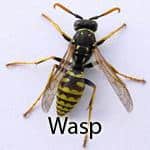Call Us Now: 330-832-4642 | 330-494-8873

Size: 1/2 to 1 1/2 inch
Color: Black, hairless bodies with striping
Where found: Trees, shrubs, under wood structures
Potential treatment: Exterior Spray
Wasps differ from bees in that they have two sets of wings and no hair on their bodies. A stinging wasp can sting repeatedly, whereas a bee can sting only once.
Most wasps use insects to feed their young and feed on nectar as adults. Some, of the solitary variety, do not build nests, while others live in colonies and may build nests in trees, protected areas or in the ground, depending on their species.
Watch for different species of wasps in and around your yard, including the European paper wasp, the northern paper wasp, the pipe organ mud dauber and the eastern cicada killer. All are common in both urban and rural settings, but type of nest and other habits vary.
European paper wasp
Colonies are started by a female, who establishes the recognizable paper celled nest in a protected area. Females lay one egg in each cell and workers feed the young chewed up caterpillars. Adults eat nectar and honeydew produced by aphids. Paper wasps do not have queens, and their colonies are started by any female who begins building a nest in the spring. Colonies will grow from a few dozen to potentially more than 100.
Northern paper wasp
These are the most common paper wasps in Northeast Ohio. As is the habit with paper wasps, any female may start a colony by building a nest in the spring. If more than one female works on the nest, one eventually establishes dominance. Nesting, reproduction and feeding habits are similar to the European paper wasp, including the location and appearance of their distinctive open-celled nests.
Pipe organ mud dauber
Named because their nests resemble pipe organs, these wasps build mud tubes in which to lay eggs. Linear mud tubes are constructed on walls and in protected areas. They vary in length, much like the pipes of an old style church organ, with some as long as six inches and containing three to four separate cells for eggs. Females usually gather several spiders, paralyze them, and stock the cells before laying eggs. These wasps are prevalent from mid-June into early September.
Eastern cicada killer
Also known as ground digger wasps, these are the largest wasps found in Ohio. The females dig tunnels that may be three feet long and two feet deep. Their name comes from the fact that they feed their young exclusively on cidadas. In a habit similar to the mud dauber, these wasps hunt cicadas in the tree canopy, paralyze them, then stock their nest with them, placing up to three cicadas in a cell holding one egg. The young hatch in a day or two, feed on the cicadas, then spin a cocoon to grow over the winter and emerge as adults in the spring.